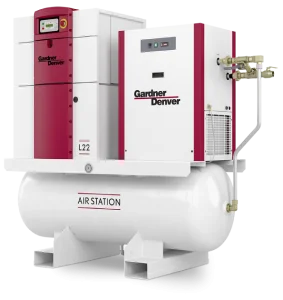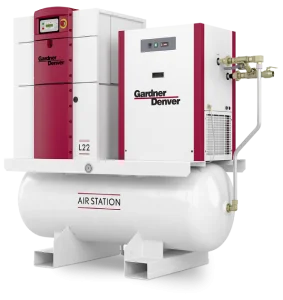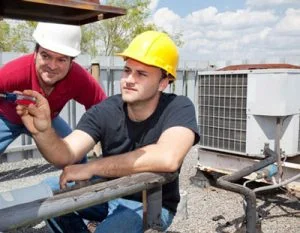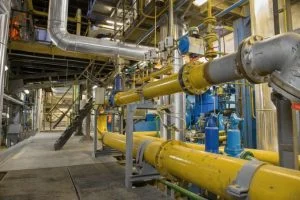 Some Things to Consider...
Some Things to Consider...Many customers because of a lack of plant floor space or due to safety (noise / heat related) requirements install their compressed air stations outdoors.
If this is you? It is highly recommended you use some type of weather protection to keep blowing rain, snow, ice or dust from entering your air compressor intake. NEMA 4 controls and TEFC motors and sound enclosures can be supplied by the manufacturer but some type of protection such as a lean-too cover or awning is always recommended.
Several customers in my area use a metal canopy or a pitched roof cover on concrete slab next to an exterior building wall and have either fence wall around the area or some will use tarp walls, put up primarily in wintertime, to trap heat from the compressor.
For cold weather operation, I have pasted below an excerpt taken from one of the GARDNER DENVER service manuals:
Figure 2-3 – COLD WEATHER INSTALLATION INSTALLATION FOR COLD WEATHER OPERATION (Figure 2-3) - It is recommended that the unit be installed inside a shelter that will be heated to temperatures above freezing (32 F, 0 C). This will eliminate many of the problems associated with operating units in cold climates where freezing rain, drifting snow, freezing condensate and bitter cold temperatures are encountered.
Refer to Gardner Denver Engineering Data Sheet 13-9-411 for the advantages of using AOL desktop gold customer service the heat recovered from your rotary compressors. This heat recovery could easily pay for an adequate shelter for the unit.
When an outside installation must be made, the precautions required will depend on the severity of the environment. The following are general guidelines for outside installations:
Cold Weather (Down To +10 F, -12 C)
1. Be sure all drains, traps, and control lines, including pressure transducer lines are heated to avoid freezing of condensate. Heat tape with thermostat control is generally satisfactory for this purpose and can be obtained at various local plumbing or hardware outlets at nominal cost.
2. If an air-cooled aftercooler is to be used, provisions to bypass the aftercooler must be made. Since cold air contains very little moisture, successful operation can be achieved without the aftercooler.
3. Provide at least some simple shelter such as a plywood windbreak to protect against drifting snow.
4. Use only Gardner Denver AEON 9000 SP lubricant.
5. Monitor the unit carefully during start-up and operation to be sure it is functioning normally.
6. Specify NEMA 4 enclosure for electrical devices.
Another item to consider when mounting your compressed air station outdoors is your Compressed Air Receivers. If your air receivers are mounted ahead of your system dryers, bulk condensate will collect in bottom of tank and typically an automatic electronic or float drain is needed. Many companies do not run compressors on the weekend and this fluid that is collected in the bottom of tank and possibly in the air lines feeding the tank will freeze during winter conditions.
To protect yourself from future headaches it is recommended to insulate your outside pipe and also the condensate drain used on tank. There are condensate drains available with internal heaters that will also solve this problem.
As far as air filters and air dryers (refrigerated and desiccant) mounted outdoors – please see below excerpt taken from cagi.org (COMPRESSED AIR & GAS INSTITUTE) website regarding the myth of air dryers installed outdoors.
Myth: Any dryer (refrigerated or desiccant) can be installed outdoors.
Fact: All standard dryers are designed for internal installation. However, many are often installed outside, (with a lean-to roof in some cases and without a lean-to roof in some cases). Outside installation is acceptable provided there is lean-to roof with freeze / snow protection, blowing rain protection, and a roof / ceiling high enough to avoid hot air re-circulation. Outside installation of standard dryers with no roof is not recommended.
Low ambient protection such as heat tracing drains and interconnecting piping can be supplied at the time of purchase to solve this problem.
Another problem some of my customers with regenerative dryers encounter is that when the dryers are mounted in a secondary building with outside piping between buildings they have seen poor dew points or shorter desiccant life. Condensation may be formed from outside non-insulated piping or pipe drops and the downstream desiccant dryers see excessive amounts of inlet condensate that will not allow the desiccant to work properly or corrode the desiccant from excessive water.
To potentially protect yourself from this problem, it is HIGHLY recommended to have a secondary air receiver ahead of the dryer that will catch bulk water or condensate and reduce or eliminate the moisture collected on outside piping exposed to varying wintertime and summertime conditions.
It is also true that a secondary air receiver should be included for refrigerated air dryer installations for outside piping for the same downstream moisture problem.
Air receivers are a low cost item compared to downstream instrumentation or precision valves used. In fact, a small air receiver can be as low as $ 200.00.
 Quick-Lock Tubing for your Compressor Lines
Quick-Lock Tubing for your Compressor LinesYou’ve set up your dream shop for woodworking or mechanical work. Or you’re expanding into an automated production of a start-up manufacturing business. Among that shiny group of equipment is a new air compressor. You’ve laid out plans to distribute your air system around the walls with drop legs for different work areas. But have you thought about the pipe materials you’ll use?
The idea that most likely comes to mind is to head to the local home store or plumbing supply and load up some PVC pipe. But that is simply a bad choice. While it may seem attractive because of the material cost and ease of installation, it is dangerous, and in some states illegal.
There’s the instance of an employee in a Texas plant who was injured by a PVC compressed air pipe that exploded, with plastic projectiles causing lacerations in his hand. There was a case in Washington State where a section of PVC pipe exploded 27 feet about a warehouse floor. A fragment of the pipe flew 60 feet and embedded in a roll of paper. In another case in Selah, WA, a PVC pipe exploded, breaking an employee’s nose and cutting his face.
A well-recognized manufacturer of PVC products, warns against using its products with compressed gases of any kind. According to Jack Roach of Colonial Engineering: “Compressed gasses can be best described as being analogous to a coiled spring. When a PVC pipe or fitting fails when under stress from compressed gas it literally explodes like a bomb, sending shards of plastic flying several feet in all directions. Liquids, on the other hand, being compressed by only 1/10 of 1 per cent contain very little stored energy. When pressurized systems with liquids fail, the energy is dissipated very quickly, thereby creating a much lower potential for hazard.”
So what are your choices? The traditional choice is iron pipe, black or, better yet, galvanized. But installing them is usually not a DIY type job. Pipe systems, like Gardner Denver’s “Quick-Lock Tubing” now on the market offer a lot of advantages. The tubing is made of extruded aluminum specifically designed for compressed air, vacuum and inert gases. They work at pressure up to 220 PSI and temperature up to 176 degrees F. The smooth bore of the tubing is more efficient for its size. For instance, a 2 inch Quick-Lock tube will flow 476 CFM at 125 whereas a 3 inch black iron pipe will flow 495 at the same pressure. The tubing fully complies with ANSI B31.1 power piping system code. Available sizes range for ½ to 2 ½ inches.
Quick-Lock fittings are push-to-connect and come in variety of configurations. The fittings are made of nickel plated solid brass with stainless steel bite ring to securely hold the tubing. Accessories like clips and wire hangers facilitate fast and easy installation of the tubing.
Give us a call for a quote on your next compressed air system or for replacing your current compressor pipework.
[/et_pb_text][/et_pb_column][/et_pb_row][/et_pb_section]
 Eluding the Inevitable Downtime Production Loss
Eluding the Inevitable Downtime Production LossAt least a few times a week, I run into a common thread among customers. They are in a rush to find a replacement pump because they are currently down and losing $$ every second their production line sits being, well, unproductive. I, of course, research all options available and present a myriad of solutions for the customer. We can expedite parts to the customer so they can rebuild the pump themselves; we can rebuild the pump in a few days with parts in our stock; or we can expedite a pump from the manufacturer.
Each situation yields similar options. All of them must be considered and weighed before determining the route to proceed. Usually, money is no issue. Why? Because time = money. And the more time spent down, the more money not being made. Some plants can lose thousands, if not tens of thousands of dollars if their production halts for just a single day. Now add up a few days of downtime, extra cost of expediting parts/pump, and possible fees for not delivering a product batch when originally agreed upon. It very quickly adds up. It can get even worse if specialized parts aren’t available for weeks. It becomes a scramble to get the product moving through the pipes again.
This can be avoided with a small bit of foresight and the purchase of a spare pump and/or spare parts. In the event of a pump malfunction, a spare pump can be brought in to resume production. This then allows time to either send the original pump out for repairs or repair in-house with the spare parts that the forward-thinking customer purchased. Of course, having custom packages with specially engineered pumps might make it less economically feasible to have a spare pump lying around. That’s where purchasing repair kits would be valuable. Short of a catastrophic failure, the pump can immediately be worked on and be up and running in hours as opposed to days or weeks.
Viking Pump offers both rebuild kits and seal kits for their pumps. These kits are priced at roughly a 15% discount compared to buying the parts individually. They are shrink-wrapped and labeled for easy storage and identification. We highly recommend keeping one of each kit in stock. Not only can normal repairs be performed the day a pump goes down, the threat of costly down time is circumvented and product keeps on flowing.
Feel free to contact me if you are interested in purchasing spare pumps/parts for your current applications.
 Basic Pumping Principles 102
Basic Pumping Principles 102Last spring I was visiting with one of our customers in Middle Georgia.
They were having two problems with an application involving a Viking L4724 Positive Displacement Internal Gear pump. Basically the pump was being used to recirculate their material in a large storage tank. However, they also used it to introduce some additional material by adjusting some valves in their pipework.
The first issue was a loud racket being made by the pump when they started it up to add material to their process.
The second issue was the amount of time it was taking to pump down a 55 Gallon drum which is where the material comes from that they want to add to the recirculation tank.
When I approached their process with their engineer I asked him if it was ok if I stated the obvious, to which he replied “sure.”
The first thing I pointed out was the distance between the pump suction port and the Tee/Valve where they change the intake material was nowhere near long enough. Basic Pumping Principles 102, you need a straight run of pipe 10 times your pipe diameter to allow for proper friction loss before your liquid enters your pump. This was causing the pump to cavitate which was causing the racket they were hearing upon pump start up.
The next thing I pointed out was that they were using a 1” steel pipe connected to about 8 feet of 1-1/2” hose connected to their 2” Tee, located about 6” from their pump inlet, in order to pull the liquid out of a 55 gallon drum. Can you say starvation AND cavitation?
I spoke to their engineer and he agreed that these issues were a problem but they couldn’t be fixed and he wanted me to solve the two problems as best I could based on these conditions.
He felt that putting a VFD (variable frequency drive) on the motor of the pump would allow them to start it ‘softer’ and ramp up allowing material to get to the pump before it hit full speed and he figured that should stop the racket and possibly drain the 55 gallon drum a little bit quicker.
Well, the customer is always right. I told him that I didn’t think a VFD would solve his problems but if that’s what he wanted then that’s what we would quote him.
The moral of the story is, know your pumping basics BEFORE you build your pump system. A good foundation in pumping principles would have done wonders for their process and would have negated these issues from the beginning.
Don’t make this mistake yourself. If you have questions, call us. That’s what we are here for.


